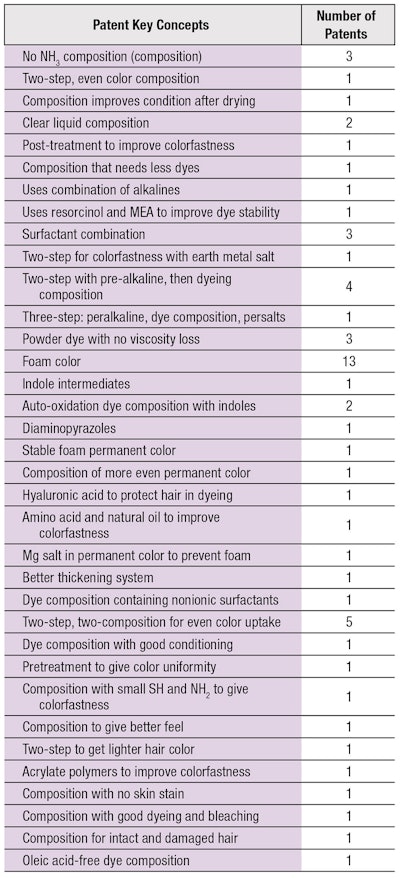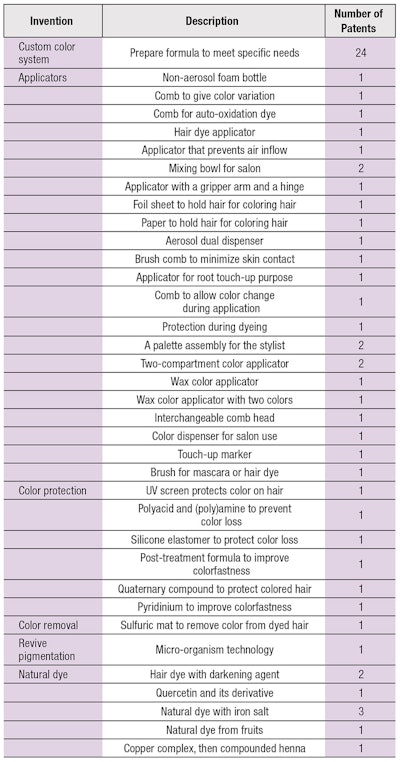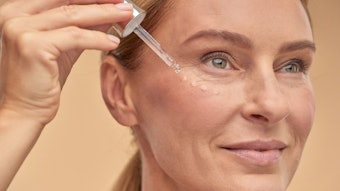
Read the full article in the November/December 2020 digital edition. . .
Hair color is the third largest category in the hair care market after shampoo and conditioner, and is expected to grow even further; at a CAGR of 3.81% between 2018-2025.1, 2 In the early days of the pandemic during quarantine, however, sales of at-home hair color kits soared; Henkel’s eSalon brand saw a 500% increase in orders and Madison Reed’s sales grew by 750%.3
Considering the popularity of hair dyes, it is not surprising to see a myriad of commercial advertisements for them on the internet and television. On the other hand, technical information about hair color remains relatively scarce, compared with other personal care categories such as skin care. This brief review means to fill the void since the excellent review by Corbett in 1998.4
Color Categories and Forms
Since the review by Corbett, categories of hair color products have basically remained unchanged. Although not necessarily as popular in all markets, these products can be classified as: permanent and demi-permanent, semi-permanent, temporary and progressive colorants. Natural hair colorants may occupy another segment in stores but these actually fit into either semi-permanent or temporary colorant categories.
One may also categorize hair color products according to form. They are usually introduced as a liquid, which is the most popular in the U.S. market. Cream formulas seem to be in greater demand in South America, Europe and Asia. Hair colorants are also sold in gel, powder, foam and powder forms. Permanent and demi-permanent hair colorants can be formulated into these product structures whereas semi-permanent and temporary colorants can be purchased in the form of solid sticks, in containers with a brush, or in aerosol sprays.
Permanent and Demi-permanent Color Developments
As is well-known, permanent and demi-permanent colorants do not use dyes. Instead, they contain colorless molecules known as intermediates. During the dyeing process, these diffuse and undergo chemical reactions simultaneously in the hair to form colored materials that are then trapped inside the hair. As a result, these colored materials have long-lasting effects inside the hair. This is the fundamental chemistry performed in the hair dye category and it has remained unchanged for decades, although efforts have been made to find new dye intermediates for product compositions.
Bringing new intermediates to the market is a big endeavor. There are several factors to be considered, such as: the chemical viability of them as color intermediates, their cost of production and development, their safety and any skin irritation issues, their stability in hair colorant formulas—and most importantly, regulatory concerns. It is therefore not surprising to see only a handful of patents within the last decade claiming to use new dye intermediates to color hair.5 Even within the last 20 years, launches of new intermediates are limited to a few, including derivatives of diaminopyrazole6 and methoxymethyl-p-phenylenediamine.7 The former is capable of imparting a bright red tone on hair, and the latter is said to develop dark shades with low sensitization potential.
In the meantime, there is no lack of activity by marketing to create a better image of hair color products. Manufacturers and suppliers alike promote formulas or ingredients for all sorts of benefits. The most obvious claims include: providing good gray coverage, delivering splendid highlights, protecting the hair with protein complexes, repairing hair’s inner structure for stronger and healthy-looking hair, and being a convenient root touch-up kit. Some products simply state they do not contain ammonia, parabens, p-phenylenediamine and resorcinol but provide no rationale for such exclusivity.
Scanning through the U.S. patent database5 provides a range of innovative product ideas. While it is unlikely that all of these patented innovations will be reduced to practice and result in new colorant launches, some are worth mentioning and could very well be in the developmental stages in certain product development laboratories. Table 1 gives a summary of the main themes of those patents.
This table reiterates the thinking that there is little interest in new dye intermediate innovations. Over the past ten past years, only two patents mention dyeing with new intermediates. For the others, the focus is improving the performance of dye formulas. The topics most relevant to the current market are most likely those focused on low ammonia odor, damage to hair and color fade.
At one time, permanent foam color was popular in the retail market. This is reflected in a surge of patent activity during that period. However, since consumer acceptance of this product form soon diminished, foam hair dyes have faded out and there is no apparent recent patent activity in this area.
Numerous patents cover ideas for multi-step treatments. The procedures described vary from pretreating to post-treating hair with different recipients. These procedures arguably can be difficult for do-it-yourself home users (DIY’ers) to follow due to the complexity of extra steps, and while perceived to bring genuine benefits to dyed hair, such steps are still probably more apt for salon applications.
Semi-permanent and Temporary Color Developments
The key focus for this class of hair colorants is mild to low hair damage. Semi-permanent and temporary colorants are an alternative choice for individuals concerned with the damage permanent hair colorants can cause. Those whose hair has recently been bleached with persulfate salts also choose semi-permanent and temporary hair colors to avoid further weakening of the hair.
Patent activity in this area is relatively lower, as expected, since semi-permanent and temporary colorants have a much lower market share than permanent colorants. Some inventions are shown in Table 2. Again, due to the high financial burden on new dye developments, not many new dyes are introduced into the market.5 Perhaps the most significant has been the introduction of blue methoxyphenoxazinium dye, which is said to give a strong and stable blue color on hair. Another interesting patented idea is the utilization of dye molecules with multi cationic functionalities. Semi-permanent colorant users often remark they would like to see color that is longer-lasting. The technologies in the collection of patents in Table 2 suggest these cationic dyes can complex with the negative charge sites on hair and make semi-permanent hair color last longer.
Other Innovations in Hair Colorants
Besides new dye molecules and improved formulas, there are other related activities in the patent database.5 One area is in the creation of systems that can view and analyze the hair of a patron to produce a custom-prepared formula as a result of the analysis (see Table 3). This is probably an answer to the long sought demand for custom colorants in the market as these systems can create consultations on demand before the customer moves to purchase online or in a store. Similarly, salon professionals can combine their experience and the analytical results from such systems to customize a formula exclusively for their customers. The development of cell phone apps, for example, allows consumers to view the color on their hair before applying the actual product.
In addition to digital technologies, besides product help lines and systemic services from traditional hair colorant producers, there are now e-salons to offer consultant advice. Customers can obtain consultation through the internet and purchase their tailor-made colorants online.
Table 3 also records numerous applicator inventions. These are designed to make the dyeing process easier and less cumbersome. Some of the inventions described in the patents are intended for retail products but others are designed more for professionals.
Furthermore, attention paid to the dyeing process has given way to patents for post-treatment products. Various ingredients are said to be able to prevent the color fade from hair. For example, a patent by Henkel claims the use of isoalkylphosphoric acid ester salts (U.S. Patent 10,266,320) in post-treatments. Treating the hair with alkaline metal salts or salts of hydroxy-polycarboxylic acids is another example (U.S. Patent 9,839,590). A sunscreen, p-methoxy cinnamidopropyl dimethyl behenyl ammonium chloride, is specified for this application in U.S. Patent 9,463,337. Furthermore, a mixture of polyacids and polyamines to seal the hair surface in order to prevent color leakage was suggested in U.S. Patent 9,186,314.
Some patents also attempt to address the demand for natural dyes, which is always on the wish list of hair colorant users. Not many genuine natural hair colorants are currently offered. This could be due to the availability of the dyestuffs or the coloring efficiency of the products. Inventors are aware of such deficiencies and trying to improve their performance using different techniques.
In the natural dye area, quercetin and its derivatives have been mixed to afford stable color on hair (U.S. Patent 9,345,654). Here, the authors believe the mixture of two quercetin derivatives has better dyeing capability. A combination of iron salt and tannic acid also has been reported to develop color in hair (U.S. Patent 8,579,992). Finally, fruits rich in polyphenolic materials have been combined to prepare dye mixtures for hair (U.S. Patent 8,361,167).
Importantly, these patent claims may not have been scientifically proven or verified. However, they do give indications of what the industry has been working on in the last decade.
. . .Read more in the November/December 2020 digital edition. . .
References
- Grand View Research (2018 Mar). Hair care market size, share and trend analysis report by type, by product, by region, competitive landscape, and segment forecasts 2018-2025. Available at: https://www.grandviewresearch.com/industry-analysis/hair-care-market
- Transparency Market Research (accessed 2020, Sep). Hair color market–Global industry analysis, size, share, growth, trends and forecast 2017–2025. Available at: https://www.transparencymarketresearch.com/hair-color-market.html
- Grabenhofer, R. (2020, Jun 1). Editor's note: Erratic swings in color and care. Available at: https://www.cosmeticsandtoiletries.com/marketdata/Editors-Note-Erratic-Swings-in-Color-and-Care-570830891.html
- Corbett, J.F. (1998). Cosmetic science monographs number 2. Hair Colorants: Chemistry and Toxicology. Micelle Press, Dorset, England.
- U.S. Patent and Trademark Office (accessed 2020, Sep 29). Available at: http://patft.uspto.gov/netahtml/PTO/index.html
- Clausen, T., Kern, U. and Neunhoeffer, H. (1991, Oct 29). Oxidation hair dye composition containing diaminopyrazol derivatives and new diaminopyrazol derivatives. U.S. Patent No. 5,061,289, assigned to P&G. U.S. Patent and Trademark Office.
- Goettel, O., Pirrello, A., Hayoz, A. and Braun, H.-J. (2003, May 6). Process for dyeing keratin fibers comprising 1,4-diamino-2-methoxymethylnenzene and salts thereof. U.S. Patent No. 6,558,433, assigned to P&G. U.S. Patent and Trademark Office.














